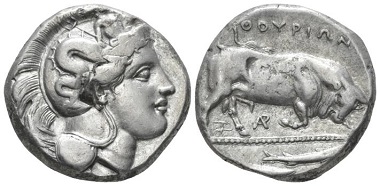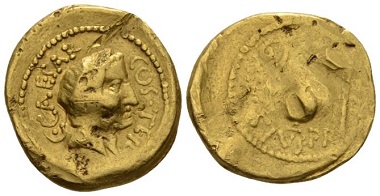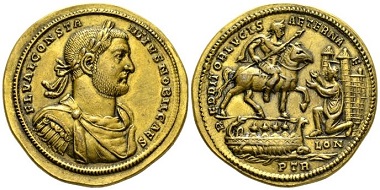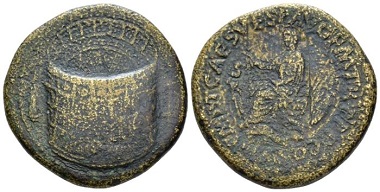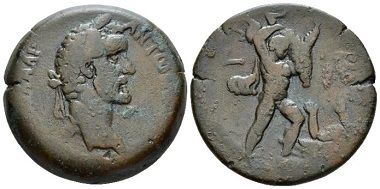16-09-2017 – 01-01-1970
Live Auction 34
Naville Numismatics’ Live Auction 34
The auction features a selection of 632 lots of Greek, Roman, Byzantine coins, all chosen with contribution from NAC’s experts. The auction will close on Sunday 17 September 2017, 16.00 UK time, at which time the live session will begin.
Lot 15: Lucania, Thurium. Di-Nomos circa 350-300. Good very fine. Starting Bid: 250 GBP.
The sale begins with a selection of coins, including bronzes and fractions, from Magna Graecia and Sicily, most of them from the E.E. Clain-Stefanelli Collection sold in association with Stacks Bowers Galleries. This section of the sale includes coins from rare mints such as Uxentum, Motya and Segesta and also offers an attractive series of coins from Tarentum, Metapontum, Thurium, Croton, Syracuse, and Athens, even beyond a selection of Hellenistic portraits of Seleucid and Ptolemaic kings.
Lot 463: Julius Caesar and A. Hirtius Praetor. Aureus circa 46. Good fine/fine. Starting Bid: 1,100 GBP.
Highlights include a wonderful tetradrachm of Athens and an interesting series of Ptolemaic bronzes struck during the reign of Cleopatra VII.
The Roman selection boasts an interesting series of Roman Republican bronzes and a striking array of denarii, again most of them from the E. E. Clain-Stefanelli Collection. This includes a beautiful quadrigatus, a brilliant denarius of M. Aemilius Lepidus, two interesting denarii of Iulius Caesar, one with elephant and the other with Aeneas and Anchises, a rare aureus of Iulius Caesar and A. Hirtius and a beautiful denarius of Q. Voconius Vitulus. In this part, there is also an interesting selection of Republican portraits such as Iulius Caesar, Marcus Antonius and Octavian.
Lot 597: Constantius I Caesar, 293-305. Plated electrotype of an AV Medallion Treveri after a Treveri (Trier) issued 297. Extremely fine. Starting Bid: 150 GBP.
The Imperial selection of the sale features an attractive series of Augustus as well as an attractive aureus with Caius and Lucius, an hybrid aureus of head of Nero on obverse and the Domitian’s type on reverse, a brilliant denarius of Domitian, a rare sestertius of Trajan with the Dacia on reverse, a scarce sestertius of Claudius Albinus, a rare aureus of Geta and a very rare electrotype of a medallion of Constantius I Chlorus made by Etienne Bourgey in 1920s, even beyond a selection of denarii, sestertii, dupondii and asses which included Claudius, Nero, Vespasian, Domitian, Trajan, Hadrian, Antoninus Pius, Faustina I, Marcus Aurelius and Gordian III.
Lot 497: Titus, 79-81. Sestertius, 80/81. From the Clain Stefanelli collection. Extremely rare. Very fine / good fine. Starting Bid: 2.000 GBP.
It is also remarkable a wonderful sestertius, from the E.E. Clain Stefanelli collection, of Titus caesar with the Amphitheatrum Flavium (the Colosseum) on obverse.
Lot 271: Egypt, Alexandria. Dattari. Antoninus Pius, 138-161 Drachm circa 141-142 (year 4). Very fine. Starting Bid: 700 GBP.
The Roman Provincial part of the sale includes a selection from the Dattari Collection. It is composed of Alexandrine coins from Octavian to Galerius with various types of obols, diobols, hemidrachms, and drachms featuring rare portrayals of ancient divinities. Highlights include coins of Augustus, Claudius, Domitian, Trajan, Hadrian, Antoninus Pius and Lucius Verus, remarkable specimens both for the state of preservation and rarity.
Giovanni Dattari was born in Livorno on 19th April 1858 and moved to Egypt with his family after the death of his father in 1875. He is known to have been a keen and competent amateur-merchant of Egyptian antiquities and Greek and Roman coinage. His study in the family villa in Cairo was a common meeting place for archaeologists, Egyptologists and numismatists.
Dattari started his coin collection in 1891 and by 1894 it was comprised of 395 pieces in base silver and 2207 in bronze. By 1903 the collection had grown to 6835 Alexandrian, 91 archaic Greek, 230 of Alexander the Great, 910 Ptolemaic, 19320 Roman coins and 630 lead and silver pieces and in the following years this number of coins more than doubled.
His corpus consists of 327 pages (of which four are missing); it begins with a bronze of Augustus and ends with an astonishing quantity of extremely rare issues of Domitianus. Dattari listed all the coins in his collection and reproduced them by pencil tracing over casts.
Giovanni Dattari died in 1923, leaving his wife Eudosia Zifà and his two children, Maria and Marco Aurelio.
Dattari had already donated a substantial number of Alexandrian coins to the Museo Nazionale in Rome in 1920 and after his death the idea of donating his entire collection to the museum was prompted by his daughter Maria who wanted the collection to be made available to the public in a gallery dedicated to her father’s memory.
Naville Numismatics Ltd’s partnership with NAC guarantees highly professional numismatic service and certifies an unlimited warranty of authenticity for the lots it sells.
You may find all offered coins here.
You will find all higlights of the auction gathered on this webpage.
Absentee bidders can bid electronically through Naville Numismatics website from the day the sale is published online up to the start of the live Session.



